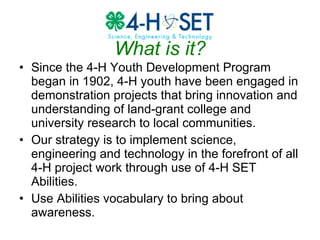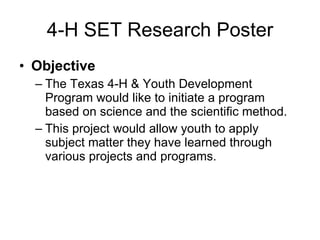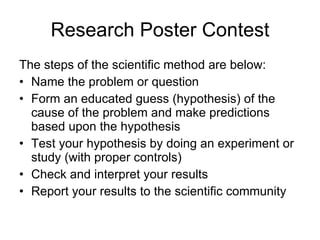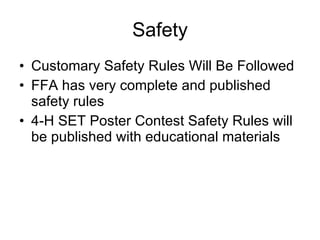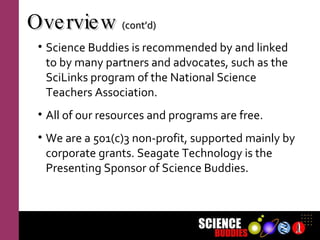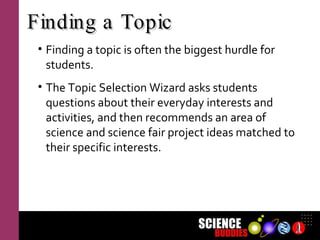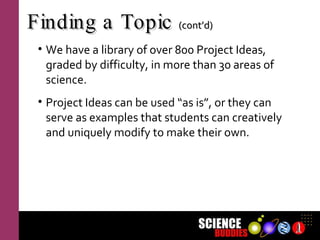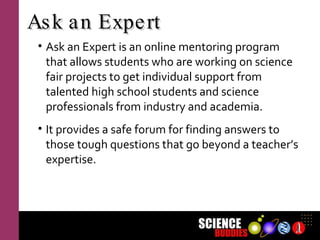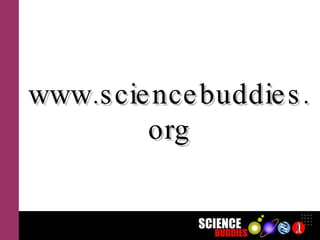S E T Centra
- 1. 4-H Science, Engineering, and Technology One Million New Scientists. One Million New Ideas. 2013
- 2. The National Initiative to increase the awareness of SET among 4-H members is an attempt to secure that the United States of America is a viable, competitive factor in the twenty first century. Youth are not scoring as high on test in the sciences as other countries, and fewer are choosing career paths. 4-H can be a valuable partner to formal education in the vision to inspire today’s youth. 4-H SET
- 3. What is it? Since the 4H Youth Development Program began in 1902, 4-H youth have been engaged in demonstration projects that bring innovation and understanding of land-grant college and university research to local communities. Our strategy is to implement science, engineering and technology in the forefront of all 4-H project work through use of 4-H SET Abilities. Use Abilities vocabulary to bring about awareness.
- 4. 4-H SET Abilities 4-H SET Abilities are identified as the 30 most recurring abilities cited in today’s scientific literature. Science abilities encompass the entirety of the cause and effect on the world around us. Engineering is recognized as a problem-solving and design process within science and technology. Technology , in the simplest term, is human innovation.
- 5. 4-H SET Addendums to Projects Addendums to 4-H Projects will be developed to use as daily reminders to project group leaders to incorporate the SET Abilities terms and vocabulary in the learning experiences they already teach. Broad examples will serve as resources to keep 4-H SET Abilities in the forefront of discussions and debriefing (reflection) after lessons.
- 6. Volunteer Involvement Faculty and volunteers will be trained on 4-H SET Abilities and incorporating vocabulary into learning experiences and project meetings. Learning experiences directed by project group leaders and faculty will use Addendum sheets as resource to develop awareness of 4-H SET Abilities . Use of uniform terminology, awareness of 4-H SET Abilities and use in everyday project work, 4-H members will become actively engaged in scientific discovery.
- 7. Recognition / New Youth Events Recognition for 4-H SET should follow the National 4-H Recognition Model Participation Progress Toward Self-set Goals Achievement of Standards of Excellence Peer Competition Cooperation
- 8. 4-H SET Research Poster Objective The Texas 4-H & Youth Development Program would like to initiate a program based on science and the scientific method. This project would allow youth to apply subject matter they have learned through various projects and programs.
- 9. Research Poster Contest The steps of the scientific method are below: Name the problem or question Form an educated guess (hypothesis) of the cause of the problem and make predictions based upon the hypothesis Test your hypothesis by doing an experiment or study (with proper controls) Check and interpret your results Report your results to the scientific community
- 10. Poster Layout The layout greatly affects the judge’s interest and understanding of your poster (display). It will be judged on the five steps of the scientific method. It should include a good mixture of text, graphics, and photos. Posters can cover topics from any field, as long as it is research oriented. Does not have to include experimental research or be focused on math or science subjects. We welcome any type of humanities or social sciences posters that meet the research criteria.
- 11. Certification by County Extension Agent Research must be approved by the County Extension Agent, with special emphasis on research projects that involved animal subjects. Research involving animals must adhere to standard experimental standards. Research certification must be complete and certified by County Extension Agent before project begins. Periodic and documented updates to County Extension Agent must be shown in research notes and included in the Notebook.
- 12. Categories Foods and Nutrition Relate to any topic in current food and nutrition issues that are relevant to their peers and their community. Broadly, these issues could include basic nutrition, food preparation, and food safety.
- 13. Categories Consumer Education Relate to any topic in the marketplace and personal factors that influence consumer choices, basic money management principles, how consumer decisions affect the economy, and the environment and/or basic consumer rights and responsibilities.
- 14. Categories Production Agriculture Relate to any topic in the production and management of field crops, forage crops, horticulture, pasture (not native range), and turf grass, or soil and/or water conservation and quality.
- 15. Categories Livestock Production Relate to the production of, or to the utilization of livestock meat, milk or fiber. Such topics include reproduction, health care, breeds and breed characteristics, or management livestock management that affects production.
- 16. Categories Environment & Natural Resources (including water) Relate to any topic related to renewable / natural resources of land, such as forestry, range, wildlife, outdoor recreation, non-agricultural soil, and water or fisheries.
- 17. Categories Engineering Relate to any projects that directly apply scientific principles to manufacturing and practical uses of any goods or services.
- 18. Categories Open Relate to any projects that are not addressed in any prior defined categories.
- 19. Categories Foods and Nutrition Consumer Education Production Agriculture Livestock Production Environment & Natural Resources (including water) Engineering Open
- 20. Age Divisions Teams or Individuals Age Divisions. The Texas 4-H Research Poster contest will follow the same age divisions as outlined in the Texas 4-H Rules and Guidelines. Topics for the Texas 4-H Research Poster Contest should be age appropriate. Research should be of a nature that the 4-H member can develop, research, process, and write a meaningful paper to the age appropriate topic. Judges decision will take age appropriateness into consideration. Team or Individual. Research projects may be an individual effort, or be comprised of a team of two 4-H members. If a team of two, both 4-H members must both keep separate notebooks, with individual notes. Combine the notes to write the paper.
- 21. Teaching the Scientific Method Science Buddies Web Resources http://www.sciencebuddies.org/science-fair-projects/project_question.shtml http://www.sciencebuddies.org/science-fair-projects/parent_resources.shtml#tc-scientificmethod http://www.sciencebuddies.org/science-fair-projects/project_experimental_procedure.shtml http://www.sciencebuddies.org/science-fair-projects/project_data_analysis.shtml http://www.sciencebuddies.org/science-fair-projects/project_final_report.shtml
- 22. Teaching the Scientific Method Intel ISEF Resources http://www.intel.com/education/isef/ Printable Thirteen-week Guide for After-school http://www.intel.com/education/isef/middleschool.htm Look to the middle right of web page for Download the Materials
- 23. Poster Evaluation Criteria Innovation / uniqueness of idea Poster presentation Two minute overview Interview and responses to questions Notebook
- 24. Poster Guidelines Typically the size of a table-top downing exhibit. Posters must stand upright on a table once unfolded. The poster should include an abstract, introduction, background, methodology, results and/or conclusions
- 25. Poster Presentation Only 4-H members submitting research posters and judges panel will be allowed in the event area. Poster display and setup may only be done by 4-H member(s). 4-H member(s) will make a two-minute presentation to a judging panel during at the beginning of the judging time. There will also be ten-minute interview times where judges will have the opportunity to ask questions to youth regarding their research project.
- 26. Jr. & Int. Research Notebook Juniors and Intermediates: Notebook should chronicle the 4-H members work on the chosen research topic. Suggested entries could be - reason for choice of topic, initial question, basic knowledge of topic, major resources for determining question refinement (literature search), hypothesis, scientific methodology of research (experiment design), initial results and testing results, and conclusion. Use of notes during research is highly desirable to be included in notebook.
- 27. Senior’s Research Notebook Seniors: Notebook should chronicle the 4-H members work on the chosen research topic. Notebooks must include accurate, timely and original notes of implemented project. They should also contain the following headings: Title Page Table of Contents Abstract Introduction Materials and methods Results Discussion and conclusions Acknowledgements Literature cited
- 28. Safety Customary Safety Rules Will Be Followed FFA has very complete and published safety rules 4-H SET Poster Contest Safety Rules will be published with educational materials
- 29. Online Resources to Help You and Your Students Achieve Science Fair Success The Presenting Sponsor of Science Buddies is Seagate Technology.
- 30. Overview Science Buddies (www.sciencebuddies.org) provides free online resources for K-12 students and teachers doing science fair projects. We have resources for fair administrators, teachers, parents, and students. Resources are designed not only to help you and your students have a successful science fair experience, but also to improve project quality.
- 31. Overview (cont’d) Science Buddies is recommended by and linked to by many partners and advocates, such as the SciLinks program of the National Science Teachers Association. All of our resources and programs are free. We are a 501(c)3 non-profit, supported mainly by corporate grants. Seagate Technology is the Presenting Sponsor of Science Buddies.
- 32. The Home Page
- 33. Finding a Topic Finding a topic is often the biggest hurdle for students. The Topic Selection Wizard asks students questions about their everyday interests and activities, and then recommends an area of science and science fair project ideas matched to their specific interests.
- 34. The Topic Selection Wizard
- 35. Topic Selection Wizard (cont’d)
- 36. Finding a Topic (cont’d) We have a library of over 800 Project Ideas, graded by difficulty, in more than 30 areas of science. Project Ideas can be used “as is”, or they can serve as examples that students can creatively and uniquely modify to make their own.
- 37. Project Ideas
- 38. Project Ideas (cont’d)
- 39. Project Ideas (cont’d)
- 40. Project Ideas (cont’d)
- 41. Project Ideas (cont’d)
- 42. Tools and Techniques Detailed guides to specific areas of science provide basic tools and methods that can be utilized to complete a project. They allow teachers greater ability to help students with projects outside their immediate subject area. Combined with Project Ideas, Tools and Techniques become powerful, modular components that can be combined to help students develop unique and original projects.
- 43. Tools and Techniques (cont’d)
- 44. Doing the Project The Project Guide outlines the scientific method and steps of the science fair process and contains information on doing engineering, math, and computer programming projects, too. Printable versions of the Project Guide are invaluable as classroom handouts. Advanced topics (e.g. writing an abstract) are included, in addition to more basic topics (e.g. formulating a question).
- 46. The Project Guide (cont’d)
- 47. The Project Guide (cont’d) Articles explain key concepts in language that students can understand.
- 48. The Project Guide (cont’d) Examples help students understand what makes a quality assignment.
- 49. The Project Guide (cont’d)
- 50. The Project Guide (cont’d)
- 51. The Project Guide (cont’d) Checklists allow students to self-evaluate their own work.
- 52. The Project Guide (cont’d) Printable worksheets guide students through critical steps of the science fair process.
- 53. Ask an Expert Ask an Expert is an online mentoring program that allows students who are working on science fair projects to get individual support from talented high school students and science professionals from industry and academia. It provides a safe forum for finding answers to those tough questions that go beyond a teacher’s expertise.
- 54. Ask an Expert (cont’d) Students can ask questions throughout the entire project or just about a specific problem. Forums are arranged by grade level to offer grade- and age-appropriate support to students. Mentoring by science professionals dramatically improves project quality.
- 55. Ask an Expert (cont’d)
- 56. Science Fair Time A variety of resources are designed specifically to prepare students for a science fair. We have tricks for preparing display boards, tips to help students prepare for judging, and advice for preparing for top competitions. Resources are available through the “Project Guide” and the “Competitions” tabs on the Science Buddies homepage.
- 57. Teacher Resources Resources were created to support teachers who have their students participate in science fairs. Resources include: Teacher’s Guide to Science Projects Guide to Planning a Science Fair Grading Rubrics Teacher and student timelines Scientific Method Classroom Poster Science Project Enrichment Tools
- 58. Teacher Resources (cont’d)
- 59. Scientific Review Committee (SRC) and Rules Advice Science Buddies offers an easy-to-understand outline of the international rules for pre-college science competitions, as well as general safety guidelines. Always check with your local fair’s SRC or fair director with questions about any rules. An overview helps students, parents, and teachers understand why compliance is so important.
- 60. SRC and Rules Advice (cont’d)
- 61. Engineering Projects Engineering and computer science projects don’t follow the scientific method—they follow the engineering design process—but they are still valid science fair projects. Engineering and Programming Project Tips explain the steps of the engineering process and how the engineering design process differs from the scientific method. An Engineering Design Process poster will be available in fall 2008.
- 62. Engineering Projects (cont’d)
- 63. Extra Help Additional resources include: Guide to science fair project photography Guide to keeping a lab notebook Listing of supplies and materials sources Student blogs And much more…
- 65. Intel ISEF Transparincies ISEF Teacher Guide Judging Scorecard Basic



